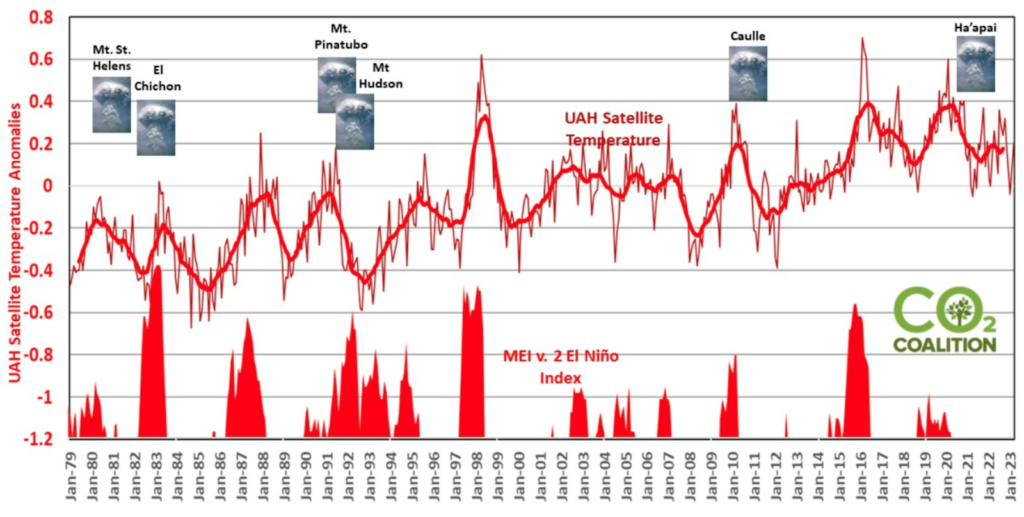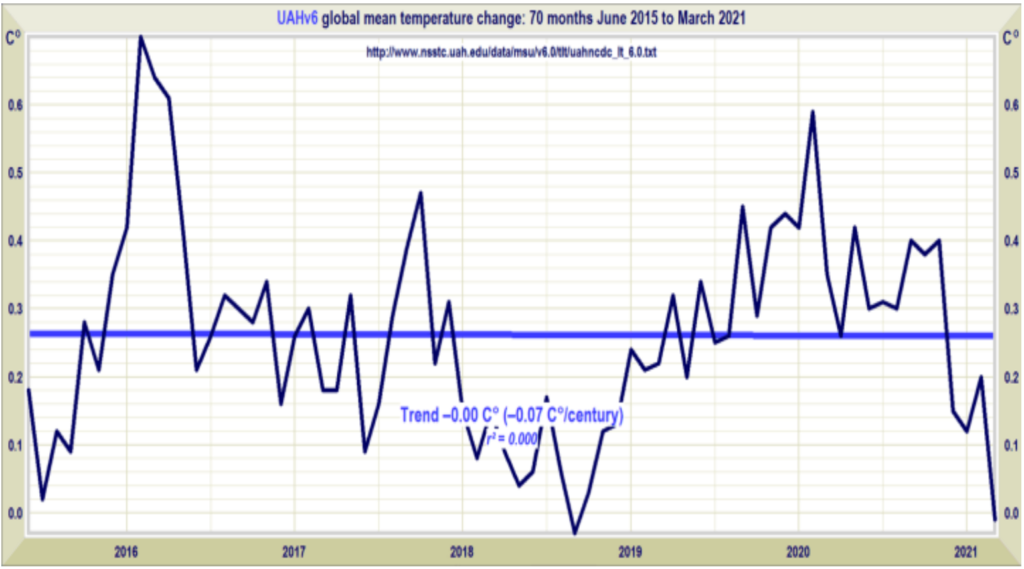
July 20, 2023
Perspective by Stephen Einhorn
It was clear that 2023 would be a hotter year if there were an El Nino, the event which occurs every several years on earth when the winds from the Pacific Ocean beat up the waves and generate heat that subsequently heats up the earth. Attached is a chart which demonstrates that when we have a warm El Nino year, the earth heats up. And 2023 is an El Nino year!

This heat has almost nothing to do with atmospheric carbon dioxide, which since 1970 has provided us with minimal heat (less than 1/2 % of the earth’s radiant energy). The last El Nino year was 2016 and it was the hottest year in our lifetimes. The earth has been cooler for the past 6 years. This is something that few Americans know. If global warming is such a big deal, why don’t we know this? Could it be that the Climate Alarmists and major media don’t want us to know? And could it be that the experts who would like to share this information cannot get access to the American people?
During the last 140 years, the average global temperature has increased by about 1 degree Celsius (1°C). Virtually every scientist agrees that this is true, and that a partial cause of this temperature increase is burning fossil fuels (Oil, coal and natural gas), which increase atmospheric carbon dioxide.
On the other hand, there is significant disagreement as to how this affects our future. The majority of scientists believe that our future will be very hot and we must attack global warming and climate change right now; while a minority believes they are following Thucydides statement of 2000 years ago in his book about the Peloponnesian Wars, and that when we “look at the past as a key to the future”, it appears clear that any projection supporting an overheated Earth is highly unlikely and contrary to empirical science.
Ask yourself whether you think it is remarkable that the average temperature of the Earth has fluctuated yearly by less than 1°C for over 140 years? How blessed we are to have so minimal a climate change over such a long period! The Earth’s temperature has been warming for thousands of years. During the most recent glacial period, the “Ice Age,” the ice grew to more than 12,000 feet thick as sheets spread across Canada, Scandinavia, Russia, and South America. The Earth’s huge increase in warmth since the Ice Age 18,000 years ago was obviously before human carbon dioxide emissions could possibly have been a factor.
Last year, I had the chance to speak with 50 of the brightest high school seniors in our country. They had just won scholarships in a contest which over 4000 students entered. I asked them if they knew which was the warmest year during the past decade. Only one student knew the answer! If you read the NY Times or the Washington Post (motto: “Democracy Dies in Darkness”), the answer will be difficult to find. The Washington Post will tell you “2020 tied with 2016 for Earth’s warmest year”; the NY Times had a similar headline, but in the body of the article it acknowledges that 2020 was a bit cooler than 2016. So, why do you think the vast majority of prime sources, the side which has the majority influence on the media, government and our colleges, maintains an almost secret truth that the Earth has been cooler for the past 6 years? Do you think it is an accident that most Americans don’t know that we have had cooler weather recently?

Actually, it is quite possible that temperatures decreased more than the official increase. This is because the official measurements by the NOAA appear to overstate warmth. In 2022, Anthony Watts conducted a study of Climate Stations and found that over 90% were corrupted. This undermines the legitimacy of the long-term climate measurements. Simply put, these climate stations were placed out of scientific compliance because they were moved or placed too near concrete or paved surfaces which distort temperature measurements and makes them higher.
Since we are told daily how warm it has become, wouldn’t you expect that the warmest days in history have been in the immediate past? The fact is that the 6 largest cities in the U.S. (New York, Los Angeles, Chicago, Houston, Phoenix and Philadelphia) all had their warmest days over a decade ago, and their average warmest day was over 50 years ago. New York City reached its hottest day in 1936 and Miami in 1985. Some warmest days were only 1 or 2 decades ago like San Francisco in 2000 and Houston in 2012. There are a few cities, like Seattle which reached their peak temperature in 2021, but these are few. You might find it interesting to look up when your municipality had its warmest day.
It seems that we are continually told that global warming causes climate change and that is dangerous. You remember that 2020 was the year of the Covid-19. This was when airplanes almost stopped flying, automobile usage dropped, and most businesses and schools went virtual. In 2020, the atmosphere received a 9% reduction in carbon dioxide, the largest drop during the industrial age (since 1840). And yet 2020 was the second warmest year in history, which showed for that year no correlation between fossil fuel use and climate change. The NOAA also reported that 2021, the year more people went back to work, schools reopened and air flights expanded, was not even one of the five warmest years. Both 2020 and 2021 temperatures showed no relationship between global warming and fossil fuel use.
Here is an idea that you can try for yourself: It may not be totally scientific, but it could be fun and you will learn something about yourself.: Check and see how much a 1 degree change in temperature affects you? You probably recall that the Paris agreement tells us that if temperatures rise more than 1 degree Fahrenheit between now and 2050, there will likely be a major climate problem. My suggestion is that when you are driving with a friend, have your friend increase or decrease the car’s temperature by one degree Fahrenheit and see if you can correctly identify what change there was. My grandchildren couldn’t — and they are really smart!
Stephen Einhorn is the author of Climate Change: What they Rarely Teach in College (Climatechangeus.com) . His education includes a B.A. in Chemistry from Cornell University and an M.A. in Polymeric Materials from Brooklyn Polytech. He is the founder of Capital Midwest Fund in Milwaukee, Wisconsin.